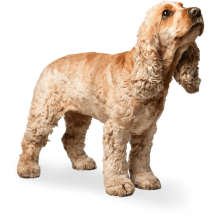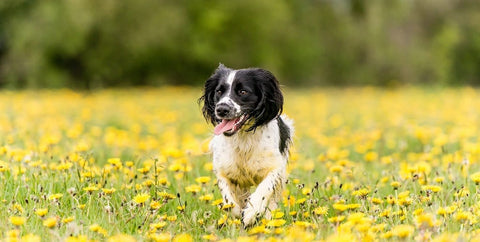

Hot spots on dogs
Spotted something amiss in your pup’s coat? A rogue patch of skin that’s sticky, matted, or crusty? Maybe it’s the size of a coin – or as wide as an orange. Is it alone, or has it brought a few friends?
Let’s take a look at what causes hot spots in dogs and what you can do about them.
What are hot spots on dogs?
A hot spot is a patch of sore or itchy skin that’s been rubbed, chewed, or scratched until the underlying layers are exposed. This often leads to oozing – and if bacteria get in, pus.
Hot spots are also known as wet eczema or moist dermatitis. Eczema usually refers to dry, itchy skin linked to inflammation or allergies, while dermatitis in dogs simply means inflammation of the skin. In this case, as ‘wet’ and ‘moist’ suggest, we’re talking about sticky – and, if it dries – crusty skin and matted fur.
Hot spots often have a well-defined edge, making them stand out from the healthy skin around them. While a dog might only have one, some develop several – usually separated by normal-looking skin. Multiple hot spots could point to a more generalised skin issue, where the hot spot is simply a symptom, not the diagnosis.
Pictures of hot spots on dogs
Other skin issues can also cause hairless, oozy, sticky or crusty patches. But with hot spots, we’re usually talking about wet or crusty skin, matted fur or possibly hairless and a clearly defined affected area.

This is a larger hot spot. The edges are harder to spot due to the coat, but the matted fur over the area sets it apart from the healthy surrounding hair.
What causes hot spots on dogs?
Anything that irritates the skin and triggers scratching, licking, or rubbing can lead to a hot spot. Common causes include:
- Bites from insects, parasites, or other animals
- Cuts and grazes
- Dog skin allergies – these often cause widespread skin irritation but can trigger hot spots in easily reachable areas where your pup chews, licks or rubs to relieve the itch
- Pain – discomfort from sore ears, blocked anal glands, or joint pain can cause your dog to fixate on one spot, creating a hot spot through excessive licking or chewing
- Matted fur or irritants like dirt or plant material stuck in the coat
In some cases, the trigger is short-lived – like a graze or bite – so the hot spot itself is the main issue. But if there’s an underlying condition, like pain or an allergy, the hot spot is just a symptom. These are more likely to come back or be slower to heal, which is why identifying the root cause matters.
Canine hot spot treatment
Technically, you might be able to treat a small hot spot at home. But often it’s best to nip it in the bud and seek veterinary advice early. Here’s why professional help makes a big difference:
- Clipping the area: Exposing the skin prevents bacteria-laden moisture from getting trapped and making matters worse. Professional clippers are safer, properly sanitised and it’s more comfortable and secure for your dog with an experienced hand (or two!) at work.
- Cleaning: Salt water can help, but vets have effective antibacterial solutions at safe concentrations– strong enough to kill bacteria, gentle enough for healing skin.
- Pain relief: Self-trauma is what turns a mild issue into a hot spot. Reducing the itch or pain that’s driving the process is essential. Only vet-approved products can do that both safely and effectively.
- Protection: Physical barriers like dog socks or bodysuits can prevent further damage. These are often available from your vet, ready to go.
-
Medication: Some hot spots need antibiotics (either topical or oral). If there’s an underlying cause, it will need treating too.

Dog hot spot healing stages
Hot spots aren’t usually deep enough to go through the full wound-healing process, but you’ll still notice some clear stages. Understanding these can help you catch them early and track recovery:
- Trigger: Something irritates the skin (an itch, injury, or discomfort), prompting your dog to focus on one area.
- Formation: Repeated licking or scratching inflames the skin and damages the surface. You might see a damp or ruffled patch of fur.
- Active hot spot: The skin becomes red and wet, possibly with pus. Fur may fall out or get matted, and there may be a smell.
- Treatment: Clipping and cleaning reveal the true extent of the hot spot, making it easier to monitor healing.
- Healing: The skin's natural barrier begins to repair. It should look less red, drier, and calmer.
- Recovery and hair regrowth: Depending on the hair cycle, regrowth can take months. In the meantime, healed skin may darken with sun exposure – so watch for sunburn on pale or exposed areas.
Hot spots don’t have to be a sticky problem. Most heal quickly – especially with support from your vet. Early treatment often means faster healing, fewer setbacks, and a much happier pup.




